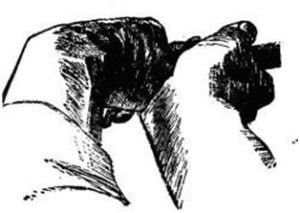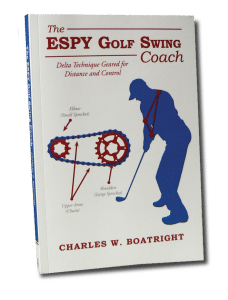THE QATSPY GOLFER’S PAGE
By: Charles W. Boatright
As a beginner golfer in my early teens, I understood the advantages of taking a mulligan. The mulligan is a second chance at a golf shot. The majority of the time the second shot was a dramatic improvement over my first shot. There is some psychology that supports why this is the case where one’s second golf shot usually has better results than the first golf shot.

The psychology of your first shot being inadequate is that it is performed predominately with your conscious mind. Even the short intervals of time while walking between golf shots on the course disrupts your subconscious routine and rhythm of being in the ZONE. This is one reason why hitting shot-after-shot on the practice range has little to no effect on the course. Each time you approach the next shot, you have to refocus. Focusing helps to quiet the conscious mind and amplify the subconscious mind where your routine and sequence are stored. This helps explain why the mulligan, on second shot, has better results. The second shot allows the golfer to focus on his/her routine and sequence.
Anytime a problem can be adequately identified provides an avenue of opportunities for advantages, since the cause of the occasional, inadequate golf shot is disruption in the golfer’s routine. The golfer must incorporate a technique I refer to as the reminder, or a mental reset. The technical term is Neuron-Linguistic Programming (NLP). This is a situation where the more you mention something, like key words, the more the subconscious mind can readily adopt and use an an instinctive behavior. Repetition and consistency are key in unlocking the power of the subconscious mind. A constant reminder during your mental reset allows the golfer to naturally follow the correct routine and sequence.
The more you bombard your conscious mind with reminders like using words, the easier it is to engage your subconscious mind during your pre-shot routine and sequence. If you don’t use a pre-shot routine, I would encourage you to start using one, including word association of essential elements. I mentally use the acronym SPY (Synch, Preset, and Yaw) to go through my three swing elements, as if I’m making the actual shot, but with my eyes closed.
Closing the eyes allows the golfer to quiet the conscious mind in order to access the subconscious mind, where the golfer’s routine and sequence are committed to memory. The subconscious mind works off a well-defined sequence, similar to the sequence of words in STOP, DROP, and ROLL, used to instruct kids on how to extinguish clothing that is on fire. Actually, this is a great quote to start one’s downswing in golf as noted in my book, The ESPY Golf Swing Coach.
Closing the eyes and mentally quoting words is like how prayer or meditation works in a person’s life. Meditation provides the muscle memory the golfer depends on to execute a confident golf shot. Meditating activates the one’s ability to get into a zone and actually believe and visualize their performance before they make the golf shot. The zone is where golfer can develop and strengthen their faith and confidence to trust their routine and sequence.
I had the pleasure of meeting and interviewing Colonel George Robert Hall, a P.O.W. held at the Hanoi Hilton for seven-and-a-half years. Before his capture, he had a four handicap. Six weeks after his release, he shot a 76 at the Greater New Orleans POW Pro-Am Open. For his story and interview, please link to http://goo.gl/24lFvo.
To improve on the Pre-Shot routine, consistency is paramount. The more frequent the Pre-shot routine is used, the easier for the subconscious mind to accept and use even under pressure of course play. Repetition of Synch, Preset, and Yaw elements is key to muscle memory. Muscle is the physical action of these three elements, but memory is the re-creation of the feel. If the golfer can feel each element being set during the Pre-Shot routine, they are reinforcing the sequence and routine for the actual shot just before it is made.
The ability to refocus was discussed as a topic on GolfFix with Michael Breed on Monday night, April 25, 2016. Dr. Nick Molinaro, a sports psychologist, used the phrase Shift attention by being aware, not distracted. Dr. Molinaro explained how the golfer should think about something totally different (consciously) between shots in order for the mind to remain fresh. I like to think about driving my Jeep along a scenic highway while walking. This allows me to use a great technique called Driving Hypnosis. While this is unsafe to drive a vehicle down the highway, it works great for driving a golf ball down the fairway.
For Driving Hypnosis to occur, three factors must be in play: (A) The task and conditions must be familiar, both normal and routine; (B) A high level of relaxation, confidence, and muscle memory must be present; (C) The main factor, the conscious and subconscious mind, focuses on two different tasks at the same time. Driving Hypnosis perfectly describes Dr. Nick Molinaro’s statement of Shifting attention, being aware not distracted, and the Pre-shot routine I explained earlier in this article.
So make your second golf shot become your first golf shot by developing a Pre-shot routine, using word association of SPY (Synch, Preset, and Yaw). Another reinforcing image the golfer can use in the Pre-shot routine is making sure the wrists, hands, and lower forearms are in the Lock Position as noted below in the left illustration.


A great method to set the CAMMING-OVER of the lead wrist and the natural CAMMING of the trail wrist is to mentally establish the TRIGGER AXIS and TARGET POINT in the above right illustration with the lead wrist. Remember, the wrist is not the lower forearm, but consists of eight small bones call carpals. For the golfer, the actual location of the wrists is a huge step in the right direction in making consistent improvements and developing more control and distance in the golf swing.
For more information about the Ergonomic SPY method, purchase your copy of The ESPY Golf Swing Coach today.

By: QATSPY GOLF Approach
Charles W. Boatright
Madison, MS
1-888-514-1228
The ESPY Golf Swing Coach– Price for Paperback $15.75 and E-Book $8.99, Hardback is also available on my website: www.espygolfapp.com/store OR your local bookstore and also:
Lulu Publishing: The ESPY Golf Swing Coach, Charles W. Boatright
Amazon.com www.amazon.com/The-Espy-Golf-Swing-Coach/product-reviews/1483416356
Barnes & Noble.com http://www.barnesandnoble.com/w/the-espy-golf-swing-coach-charles-w-boatright/1120604749
Check out my full library of BLOGS @ www.espygolfapp.com/blog or purchase your copy of “The ESPY Golf Swing Coach” @ www.espygolfapp.com/store.
Facebook – The QATSPY Golf Approach
Twitter – @cwboatright
Google+ – ESPY Golf Swing Coach
YouTube – ESPY Golf Swing Coach
Once you learn WHY, you don’t forget HOW!
YouTube Videos:
https://youtu.be/ZGVNrIw_wlo (Cam & Cam-over elements)
https://youtu.be/K2FDHZ3AX9w (Figuring your proper swing plane)
https://youtu.be/TO82PMO6G8M (Developing muscle memory)
Two decisions that you can make for yourself and your kids are to get a copy of my book and place the book and a golf club into their hands. You will never look back, but only forward. You will not miss with this for yourself and/or your kids.
A Recommendation for your Golf Game:
I would like to recommend a wonderful radio program that I regularly listen to on my I-Heart Radio app on KARN 102.9 FM station, out of Little Rock, AR. They air a golf show called “Arkansas Fairways and Greens,” at 7:00 AM CT each Saturday morning, hosted by Bob Steel and Jay Fox. Bob occasionally has on his show a guest named Shawn Humphries, a Professional Golf Instructor from Dallas, Texas. One thing that Mr. Humphries stresses is the mental part of golf, not focusing on the results but the process.
